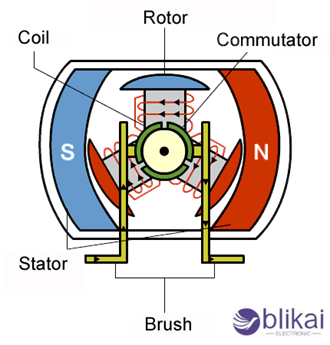What makes brushless motors so unique? Unlike conventional motors, brushless motors do not depend on contact between pieces, lowering friction and loss of power. Such a change in construction seems trivial but companies have already derived a large number of benefits because of it to the extent of performance, durability, and most of all energy consumption. In this paper, we explain how brushless motors work, quantify the energy savings, and investigate the multitude of applications that are already benefiting from this technology.
![]()
Understanding Brushless Motors
A. Definition and Basic Components
Brushless motors, otherwise called electronically commutated motors, are those types of electrical machines that do not involve the use of mechanical brushes. The basic components of these motors are a rotor containing tapered permanent magnets, a stator containing electromagnetic coils, and electronic controlling. The controller assumes the role of conventional brushes and precisely controls the electricity supply to the stator coils in order for it to produce a rotating magnetic field that further causes rotation of the rotor.
B. How Brushless Motors Differ From Traditional Motors
Unlike the conventional brushed motors, there is no physical contact between the rotor and stator in a brushless motor. This key difference results in several advantages:
- Reduced friction and wear, leading to longer motor life
- Higher efficiency due to the absence of brush-related energy losses
- Improved heat dissipation and thermal management
- Greater precision in speed and torque control
 Lower electromagnetic interference
Lower electromagnetic interference
C. Types of Brushless Motors
In their designs, brushless motors are made in a number of configurations to address various applications:
Inrunner motors: The rotor is always spinning inside the stator; hence, they provide high-speed applications but at lower torque.
Outrunner motors: The rotor surrounds the stator; consequently, they provide much higher torque at much lower speeds.
Axial flux motors: The rotor and stator are disc-shaped and are arranged flat, thus fit for applications due to limited space.
The Mechanics of Energy Efficiency in Brushless Motors
Reduced Friction and Wear
Brushless motors generate much less friction and wear than these traditional motors. Carbon brushes of traditional motors touch the commutator, producing friction and wear of the components over time. However, the brushless design is made in such a way that contact is reduced, leading to less friction, thus smoother operation. This design helps in improving the efficiency and durability of the motors.
Elimination of Brush Sparking
In the brushed motors, sparking occurs due to sliding contact between brushes and commutators, which generates energy loss and electromagnetic interference. In contrast, brushless motors utilize electronic commutation, thereby eliminating sparking, increasing energy efficiency, which in turn increases safety in sensitive environments.
Higher Power-to-Weight Ratio
Brushless motors have a significantly higher power-to-weight ratio, having the ability to deliver more power while efficiently using much less room and mass. The design of such motors enables them to use the magnetic field of the motor more efficiently. This results in a greater torque and power output relative to the overall size of the motor, which allows for the optimal use of brushless motors in applications that have a huge weight and spacer constraint.
Improved Heat Dissipation
Heat generated is very much a factor in motor efficiency, and brushless motors are best in this respect. The design allows for better removal of heat, as windings are placed on the stator (fixed part of the motor). Such a setup gives rise to rapid cooling, lowering energy losses by heating and allowing for a longer duration and efficiency of the motor itself. Better thermal management helps improve motor life and consistent performance.
Quantifying Energy Savings
Comparing Efficiency Ratings
Brushless motors are much more efficient than brushed ones in all ratings. While brushed motors generally achieve an efficiency rating of 75% to 80%, brushless motors can easily go above 85% and even 90%. This significant difference translates to substantial energy savings over time.
Real-World Energy Consumption Examples
To give some perspective on these efficiency gains, consider a practical example. If a traditional conveyor system using brushed motors requires consumption of 10 kWh per hour in a manufacturing setup, then installing brushless technology on that same system should enable a further lower consumption of about 8.5 kWh per hour. In this case, this minor difference translates into savings of over 13,000 kWh per year if operated year-round.
Long-Term Cost Benefits
Energy savings are, hence, the absolute application of this brushless motor technology which will also benefit in the long term. The cost of the brushless motor technology could still be high initially; however, with less electricity usage, it saves money on electricity bills well-settled down in time. A medium-sized factory facility changing to brushless motors might save anywhere between tens of thousands of dollars each year on energy bills.
